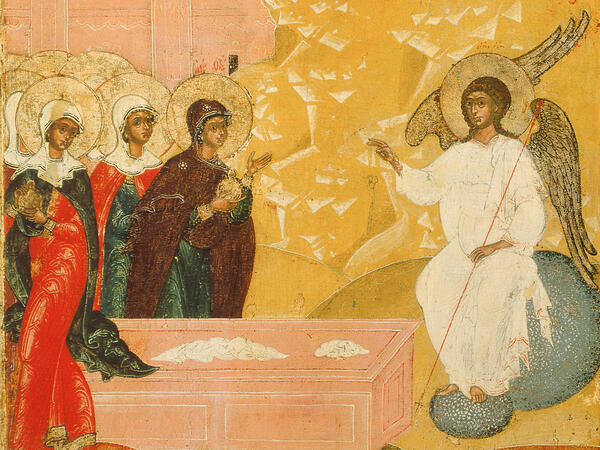Examples of Byzantine icon painting appeared in Russia at the end of the 10th century with the adoption of Christianity. Icons quickly became objects of worship and imitation. However, this did not mean that Russian icon painting was just a branch of Byzantine iconography. The process of icon painting development began already in the 12th century, and soon the diversity of national icons took shape.
The icon ‘Myrrh-Bearing Women’ displayed in the museum’s collection belongs to the Moscow School of Icon Painting of the 17th century. The rise of the school coincided with the period of growth of the Grand Principality of Moscow at the turn of the 14th — 15th centuries. Its representatives were practically all famous icon painters of Russia: Theophanes the Greek, Andrei Rublev, Daniil Chyorny, Dionisius. These artists strove to paint icons for “thoughtful contemplation.” The image had a special softness due to smooth and barely noticeable highlights applied by painters. The color scheme was dominated by light, transparent shades of blue, green, cherry brown, golden ochre.
In both Russian and Byzantine masterpieces, the scene “The Appearance of the Angel to Myrrh-Bearing Women” is included in passion cycles next to either “Descent into Hell” or “The Appearance of Christ to Myrrh-Bearing Women”, and also occurs in the festive row of the iconostasis. The icon “Myrrh-Bearing Women” features the events of Holy Week; it depicts followers of Jesus. On the night of the Resurrection of Christ, women hurried to the tomb of the Lord in order to anoint the body of the Savior with myrrh — fragrant incense — according to the Eastern tradition.
According to church texts, the myrrh-bearing women thought, heading to the tomb, about how they could move the stone blocking the entrance to the cave. At that moment, an Angel descended to earth, and an earthquake occurred, which pushed the rock and frightened the guards. The angel announced to those who came that Christ had risen.
The scene depicted on the icon by an unknown master unfolds against the background of a mountain landscape. One can see the pink walls of Jerusalem on the left, behind the backs of women in crimson and scarlet robes. The luminous faces of the myrrh-bearing women are turned to the Angel — he is on the right, sitting on a round stone. The Holy Sepulcher is presented in a rectangular slab on which there are two conventionally depicted podeai.
The icon ‘Myrrh-Bearing Women’ displayed in the museum’s collection belongs to the Moscow School of Icon Painting of the 17th century. The rise of the school coincided with the period of growth of the Grand Principality of Moscow at the turn of the 14th — 15th centuries. Its representatives were practically all famous icon painters of Russia: Theophanes the Greek, Andrei Rublev, Daniil Chyorny, Dionisius. These artists strove to paint icons for “thoughtful contemplation.” The image had a special softness due to smooth and barely noticeable highlights applied by painters. The color scheme was dominated by light, transparent shades of blue, green, cherry brown, golden ochre.
In both Russian and Byzantine masterpieces, the scene “The Appearance of the Angel to Myrrh-Bearing Women” is included in passion cycles next to either “Descent into Hell” or “The Appearance of Christ to Myrrh-Bearing Women”, and also occurs in the festive row of the iconostasis. The icon “Myrrh-Bearing Women” features the events of Holy Week; it depicts followers of Jesus. On the night of the Resurrection of Christ, women hurried to the tomb of the Lord in order to anoint the body of the Savior with myrrh — fragrant incense — according to the Eastern tradition.
According to church texts, the myrrh-bearing women thought, heading to the tomb, about how they could move the stone blocking the entrance to the cave. At that moment, an Angel descended to earth, and an earthquake occurred, which pushed the rock and frightened the guards. The angel announced to those who came that Christ had risen.
The scene depicted on the icon by an unknown master unfolds against the background of a mountain landscape. One can see the pink walls of Jerusalem on the left, behind the backs of women in crimson and scarlet robes. The luminous faces of the myrrh-bearing women are turned to the Angel — he is on the right, sitting on a round stone. The Holy Sepulcher is presented in a rectangular slab on which there are two conventionally depicted podeai.



